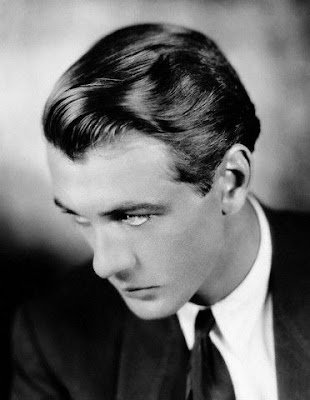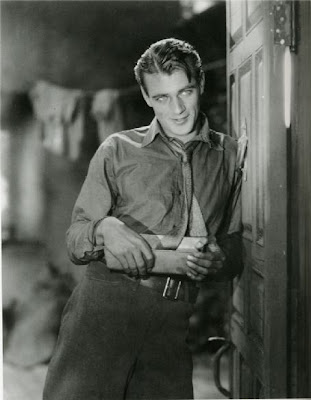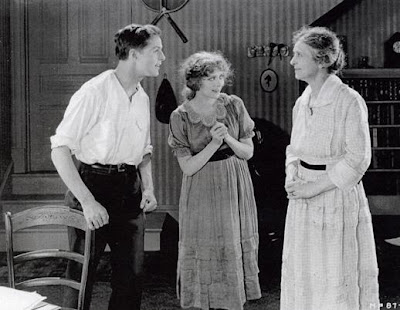
 One of the most fascinating figures of the silent era was the now forgotten [George] J[ack] Warren Kerrigan (1879-1947). When this first major gay star in Hollywood told Shadowland (October 1919) of "leading a double life", he was referencing his Irish heritage demanding a life of wandering, fighting, and adventure when, in reality, he longed for a quiet home life. Interested in the arts, showing promise in both singing and acting, young Jack also liked to paint and write. He began appearing in community theater in the New Albany and Louisville area around the age of 18, while working at his father's warehouse and attending school. He concentrated more and more on acting, making his New York stage debut in 1906. Other productions followed as Jack developed into a leading man. It was at this time that Jack became known as "The Gibson Man", so named because he was as handsome as a Gibson Girl was beautiful. "I [...] received an offer from a man in the employ of the Vitagraph in New York, but I was doing well on the legitimate stage at that time and the matter was dropped. Later, while playing in Chicago in The Road to Yesterday, a member of the Essanay made me an offer to join their company. It took me some time to overcome the prejudices of stage folk and to realize that the motion picture theater was the greatest institution for the entertainment of all the people in the world. The screen covers an unlimited field. After a month’s work before the camera, I decided that I had found my vocation. My 'up-stage' opinions faded away and I realized that a great new school of acting, comprehending unlimited possibilities, had originated in motion pictures. [...] Upon the organization of the American Company, I was the first member to be engaged. For a period of three years I played lead in every picture - sometimes at the rate of two a week - which that company produced." He joined Universal in 1913, starring in length movies, as Samson in 1914.
One of the most fascinating figures of the silent era was the now forgotten [George] J[ack] Warren Kerrigan (1879-1947). When this first major gay star in Hollywood told Shadowland (October 1919) of "leading a double life", he was referencing his Irish heritage demanding a life of wandering, fighting, and adventure when, in reality, he longed for a quiet home life. Interested in the arts, showing promise in both singing and acting, young Jack also liked to paint and write. He began appearing in community theater in the New Albany and Louisville area around the age of 18, while working at his father's warehouse and attending school. He concentrated more and more on acting, making his New York stage debut in 1906. Other productions followed as Jack developed into a leading man. It was at this time that Jack became known as "The Gibson Man", so named because he was as handsome as a Gibson Girl was beautiful. "I [...] received an offer from a man in the employ of the Vitagraph in New York, but I was doing well on the legitimate stage at that time and the matter was dropped. Later, while playing in Chicago in The Road to Yesterday, a member of the Essanay made me an offer to join their company. It took me some time to overcome the prejudices of stage folk and to realize that the motion picture theater was the greatest institution for the entertainment of all the people in the world. The screen covers an unlimited field. After a month’s work before the camera, I decided that I had found my vocation. My 'up-stage' opinions faded away and I realized that a great new school of acting, comprehending unlimited possibilities, had originated in motion pictures. [...] Upon the organization of the American Company, I was the first member to be engaged. For a period of three years I played lead in every picture - sometimes at the rate of two a week - which that company produced." He joined Universal in 1913, starring in length movies, as Samson in 1914. His career was then managed by his twin brother Wallace Kerrigan. It was also in 1914 that Jack published his autobiography, becoming the first motion picture star to do so. A song was also written about him in 1914, titled (modestly enough) The Hero of Them All. Photoplay, conducting in 1913 a popularity contest among its readers, named him the most popular male star - a very special male star, handsome but effeminate, fun loving, who lived with his mother (and his partner) in "The Kumfy Kerrigan Kottage" and once told the Motion Picture Blue Book that he loved the ladies "when they leave me alone." His career was almost ruined in 1917 when he told a local Denver newspaper that he would not go to war and that first American should take "the great mass of men who aren't good for anything". He argued that those who brought beauty to the world, such as the actor, should not be drafted. In August 1917, Photoplay's James R. Quirk brought Kerrigan's outlook to his readership, branding the actor as "one of the beautiful slackers". For scriptwriter and director Allan Dwan, J. Warren Kerrigan was "quite a lady himself", and he said there were many such "pansies and poseurs" because "Hollywood sucked them all".
His career was then managed by his twin brother Wallace Kerrigan. It was also in 1914 that Jack published his autobiography, becoming the first motion picture star to do so. A song was also written about him in 1914, titled (modestly enough) The Hero of Them All. Photoplay, conducting in 1913 a popularity contest among its readers, named him the most popular male star - a very special male star, handsome but effeminate, fun loving, who lived with his mother (and his partner) in "The Kumfy Kerrigan Kottage" and once told the Motion Picture Blue Book that he loved the ladies "when they leave me alone." His career was almost ruined in 1917 when he told a local Denver newspaper that he would not go to war and that first American should take "the great mass of men who aren't good for anything". He argued that those who brought beauty to the world, such as the actor, should not be drafted. In August 1917, Photoplay's James R. Quirk brought Kerrigan's outlook to his readership, branding the actor as "one of the beautiful slackers". For scriptwriter and director Allan Dwan, J. Warren Kerrigan was "quite a lady himself", and he said there were many such "pansies and poseurs" because "Hollywood sucked them all".
 Young William Haines (1900-1973) ran away from home at the age of 14 with his "boyfriend" and worked in a dance hall which may have also served as a brothel. He was an assistant bookkeeper at a New York bond house when he sent in his photograph to a "New Faces" contest sponsored by movie producer Samuel Goldwyn in 1922. After a successful screen test, he was signed as a contract player; and in 1922 he departed for California. It was in Brown of Harvard (1926) that he crystallized his screen image, a young arrogant man who is humbled by the last reel. "He has never been in love with any girl yet, and doesn’t intend to", stated fan magazines. In 1926, Bill Haines fell in love for twenty-one-year-old Jimmie Shields (1905-1974), who he met in New York probably as a pick-up on the street. They moved in together and became, as Joan Crawford once said, "the happiest married couple in Hollywood". Shields was put on the MGM payroll as Bill's secretary and stand-in. The two stayed together for nearly fifty years, until Bill's death. Haines was the perfect male flapper for the latter half of the 1920s. While Valentino represented the dangerous love and John Gilbert played noble, tortured heroes, Haines exemplified the sunny, collegiate self-confidence of jazz Age. His screen heroes were the happy-go-lucky fellows his fans thought themselves to be. And Bill's generally cheery offscreen personality fitted perfectly with this. In 1933, Billy Haines picked up a sailor in Pershing Square in Los Angeles and took him to the YMCA where he had a room. The house detective and L.A. Vice Squad burst in and arrested and handcuffed both men. Losing his boyish good looks after age 30, Haines accepted the decline of his star with grace. Battles with Louis B. Mayer over his "scandalous" love life finally ended his career in 1934. After that, tasteful Haines became a famous interior decorator.
Young William Haines (1900-1973) ran away from home at the age of 14 with his "boyfriend" and worked in a dance hall which may have also served as a brothel. He was an assistant bookkeeper at a New York bond house when he sent in his photograph to a "New Faces" contest sponsored by movie producer Samuel Goldwyn in 1922. After a successful screen test, he was signed as a contract player; and in 1922 he departed for California. It was in Brown of Harvard (1926) that he crystallized his screen image, a young arrogant man who is humbled by the last reel. "He has never been in love with any girl yet, and doesn’t intend to", stated fan magazines. In 1926, Bill Haines fell in love for twenty-one-year-old Jimmie Shields (1905-1974), who he met in New York probably as a pick-up on the street. They moved in together and became, as Joan Crawford once said, "the happiest married couple in Hollywood". Shields was put on the MGM payroll as Bill's secretary and stand-in. The two stayed together for nearly fifty years, until Bill's death. Haines was the perfect male flapper for the latter half of the 1920s. While Valentino represented the dangerous love and John Gilbert played noble, tortured heroes, Haines exemplified the sunny, collegiate self-confidence of jazz Age. His screen heroes were the happy-go-lucky fellows his fans thought themselves to be. And Bill's generally cheery offscreen personality fitted perfectly with this. In 1933, Billy Haines picked up a sailor in Pershing Square in Los Angeles and took him to the YMCA where he had a room. The house detective and L.A. Vice Squad burst in and arrested and handcuffed both men. Losing his boyish good looks after age 30, Haines accepted the decline of his star with grace. Battles with Louis B. Mayer over his "scandalous" love life finally ended his career in 1934. After that, tasteful Haines became a famous interior decorator.



As early as November 1929, Katharine Albert explained in Photoplay "How bachelors manage their homes". Described as a "playboy", William Haines appeared in a photograph captioned "at home, fastidious housekeeper and host, art connoisseur. The commode is Venetian, the portrait a Sir Peter Lely." Tea with Ramon Novarro was served by his "man" (Novarro's "valet" and éminence grise Frank Hansen) and consisted of "tiny finger sandwiches, chut in hearts and shamrocks, and luscious little petit fours" and that Gary Cooper (1901-1961) lived with his mother. She noted a banling ham in the kitchen, a gift from Andy Lawlor's mother in Virginia. Modern research suggest overwhelmingly that Coooper was involved in a long-term relationship with Andy Lawlor aka Anderson Lawler (1902-1959).






Just arrived in Hollywood, where he met Cooper, Lawler acted in thirty-nine films over the next ten years, his last film credit being in 1939. Seventeen of those roles however were uncredited bit parts, and in addition one role was deleted before the film was published. Lawler frequently stayed at the Cooper house at 7511 Franklin Avenue while Cooper's parents were away. When Cooper eventually took his own apartment on Argyle Avenue, Anderson casually moved in...


Gary Cooper was featured in a November 1930 Picture Play photo section headed "Boys will be boys", in which, it was explained, our virile heroes assume expressions that belong to ingénues. The photograph published must be the most effeminate ever taken of the rugged leading man? Coming a close second was David Rollins (1897-1997), of whom it was explained, "he has been coy and coquettish in so many photographs that this is no novelty."

 Among the other ''wisecrackers'' (1920s slang for gay) was Harrison Ford (1884-1957), who was reported going in a costume-buying spree for actress Norma Talmadge and being "as enthusiastic as a young debutante planning her first party dress." The actor rarely gave interviews and only talked about his professional, not private, life, so little is known of his background. An article states that he left school at fourteen to join a stock company, working his way up from stagehand to bit player. "A rather serious, secretive chap", one reporter called him. "The Hermit of Hollywood" soon became his nickname. "When discussing a question", wrote journalist William McKegg, "Mr. Ford has the trick of looking far away, or down on the ground, or glancing behind him, as though he might find the explanation in any of these directions." Harrison himself complained, "What I can't make out, though, is what you people see in any of us [actors] interesting enough to keep writing about." If Harrison had any romance, it remained unreported. The few private glimpses into his life involved his love of gardening and his large collection of books, many of them first editions.
Among the other ''wisecrackers'' (1920s slang for gay) was Harrison Ford (1884-1957), who was reported going in a costume-buying spree for actress Norma Talmadge and being "as enthusiastic as a young debutante planning her first party dress." The actor rarely gave interviews and only talked about his professional, not private, life, so little is known of his background. An article states that he left school at fourteen to join a stock company, working his way up from stagehand to bit player. "A rather serious, secretive chap", one reporter called him. "The Hermit of Hollywood" soon became his nickname. "When discussing a question", wrote journalist William McKegg, "Mr. Ford has the trick of looking far away, or down on the ground, or glancing behind him, as though he might find the explanation in any of these directions." Harrison himself complained, "What I can't make out, though, is what you people see in any of us [actors] interesting enough to keep writing about." If Harrison had any romance, it remained unreported. The few private glimpses into his life involved his love of gardening and his large collection of books, many of them first editions.
 Another gay star was Gareth Hughes (1897-1965), who had the lead in Fox's Every Mother's Son in 1918. As a young Welsh actor, his career began in 1919. The writer Fulton Oursler called him "the charm boy to end all charm boys." There seems little doubt, regardless of his angelic face, that he had a great deal of fun in the pre-code days. "The exuberance of the men and women about me impresses me deeply", he confessed to a journalist. Actress Viola Dana told historian Anthony Slide that several actress's refused to kiss him because he was so sexually active. The big question is - active with whom? Asked in 1921 by a journalist if he is married, Hughes says he is not and "he never will be. But then, you see, he is only 22. It's just a phase of youth." Gareth continued working in film in Hollywood until 1929, going back to Broadway briefly in 1925 to perform in "The Dunce Boy". After 1929 he went back to the theater, but he continued to keep a residence in Los Angeles and lived with a number of people during the 1930s. One of these, in 1936 according to Voter Registration records, was an interior decorator named Myron L. Gray. Hughes lived out his days productively as a member of an Episcopal monastery who worked with Paiute Indians in Nevada.
Another gay star was Gareth Hughes (1897-1965), who had the lead in Fox's Every Mother's Son in 1918. As a young Welsh actor, his career began in 1919. The writer Fulton Oursler called him "the charm boy to end all charm boys." There seems little doubt, regardless of his angelic face, that he had a great deal of fun in the pre-code days. "The exuberance of the men and women about me impresses me deeply", he confessed to a journalist. Actress Viola Dana told historian Anthony Slide that several actress's refused to kiss him because he was so sexually active. The big question is - active with whom? Asked in 1921 by a journalist if he is married, Hughes says he is not and "he never will be. But then, you see, he is only 22. It's just a phase of youth." Gareth continued working in film in Hollywood until 1929, going back to Broadway briefly in 1925 to perform in "The Dunce Boy". After 1929 he went back to the theater, but he continued to keep a residence in Los Angeles and lived with a number of people during the 1930s. One of these, in 1936 according to Voter Registration records, was an interior decorator named Myron L. Gray. Hughes lived out his days productively as a member of an Episcopal monastery who worked with Paiute Indians in Nevada.

1 commentaire:
Hollywood Babylon ou est-ce du bavardage hollywoodien ? :)
-Beau Mec
Enregistrer un commentaire